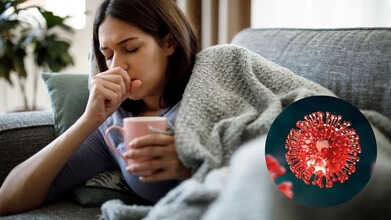- Health Conditions A-Z
- Health & Wellness
- Nutrition
- Fitness
- Health News
- Ayurveda
- Videos
- Medicine A-Z
- Parenting
- Web Stories
After Navjot Singh Sidhu Faces Backlash for Claiming 'Diet' Cured Wife's Stage-4 Cancer, Expert Details Her Treatment

Breast Cancer (Credit: Canva)
Cricketer-turned-Politician Navjot Singh Sidhu recently drew flak after he claimed that his wife, Navjot Kaur Sidhu, conquered Stage-4 breast cancer by keeping her diet clean. Following heavy criticism by oncologists and health care practitioners, he changed his statement to add that his wife underwent surgeries, chemotherapy, hormonal therapy, and targeted therapy as a part of her treatment. He also said that she never took a step without medical advice and that her diet chart merely served as a facilitator.
In India, breast cancer is the most common form of cancer in women, accounting for more than 25% of all female cancers. As per Indian Council of Medical Research (ICMR), five year survival rate of cancer patients in India is 66.4% as compared to 90.2% in developed countries like the US.
Dr Harit Chaturvedi, Chairman of Max Institute of Cancer Care, said Kaur's treatment included standard chemotherapy, surgery, radiation, etc and the outcome was a testament to the advances in modern medicine. "It was unfortunate that the scare of cancer had led to several myths and Sidhu was also adding to the list by presenting his one case and a hundred-day experience in a press conference and not at a scientific forum for scientific scrutiny," he said.
Modern Medicine Has Successful Cured 50% Stage 4 Cancer
Dr Chaturvedi emphasized the importance of evidence-based cancer treatment, noting that modern medicine has successfully cured over 50% of stage 3 & 4 cancer cases and nearly 30-50% of advanced cancer cases. He said that cancer is not a one-size-fits-all disease and treatment plans must be personalized based on various factors, including the cancer subtype, genetic changes and the extent of the disease.While Sidhu has taken back his controversial statement, Dr Chaturvedi said that public figures share the responsibility of spreading correct information as their words can influence vulnerable cancer patients. He said half-baked stories with small short-term experiences presented as scientific evidence were harming the society. Furthermore, he stressed the need for caution, evidence and scientific validation in all public discussions regarding cancer treatment.
What Is Breast Cancer?
Breast cancer remains one of the most prevalent cancers affecting women globally, with men also at significant risk. Early detection of this life-threatening disease is vital for effective treatment and improved outcomes, making regular self-examinations and mammograms essential tools. Risk factors for breast cancer include age, family history, genetic mutations, and lifestyle choices such as diet and exercise. It is pertinent to note that treatment methods like chemotherapy, hormonal therapy and radiation therapy are given to patients at advanced stages of breast cancer and can have a significant impact on a woman's reproductive system.Symptoms of breast cancer can include unusual lumps, changes in breast shape or size, and abnormal discharge. Therefore, is very important to self-screen your breasts every once in a while. The process involves looking at your breasts in the mirror and checking for bumps, lumps or discharge. You should immediately see a doctor if you notice any one of the aforementioned symptoms.
Study Reveals How Manipulative People Use THIS As A Weapon: Psychology Of Narcissists

(Credit-Canva)
Manipulation, according to the American Psychological Association, is behavior designed to exploit, control or otherwise influence others to one’s advantage. Some people Some people do this with words; others through actions. In a new study, researchers found that there is another act that manipulators often use to their advantage.
We think of a hug or a hand on the arm as comforting and connecting. But a new study suggests that these simple actions can hide a darker intention. Research in the journal Current Psychology reveals that people who are manipulative and self-centered (narcissistic) often use touch to calculate how to influence or control their romantic partners.
Senior researcher Richard Mattson points out that in these relationships, you not only miss out on the good feelings that touch usually brings like lower stress and a boost of the "love hormone" oxytocin, but the touch is actively used to benefit the manipulative person, often hurting their partner in the process. This work connects how someone touches with who they are.
How Do Narcissists Manipulate With Touch?
Most studies look at the positive effects of touch, but this research focused on the opposite: when touch is used to harm or trick someone. The study centered on people who showed traits belonging to the "Dark Triad," which is a group of three linked, negative personality traits:
Narcissism: Being extremely self-focused, needing admiration, and lacking empathy for others.
Psychopathy: Having very little empathy (inability to understand others' feelings) and acting impulsively.
Machiavellianism: Being cunning and manipulative to reach personal goals, often deceiving others.
The researchers surveyed over 500 college students about their comfort with touch and how they used it in relationships. They found that people with high levels of these dark traits were significantly more likely to use touch as a tool to control, influence, or manipulate their romantic partner, proving it wasn't about affection but about power.
Does Gender Affect How Manipulators Act?
The study revealed some interesting gender-based difference in how these manipulative traits showed up:
Men with these darker traits tended to use touch in an effort to feel more connected to their partner. This was especially true if they already felt insecure or unstable in the relationship, using touch as a way to reinforce their bond or ease their own anxiety.
Women with "Dark Triad" traits often reported feeling uncomfortable when they were touched by others. However, they were still more likely than others to use touch themselves as a means of controlling or influencing their partner.
Experts summarized the core attitude of these personality types as "me first, you second." This self-serving belief is so strong that it affects even how they handle affection and physical closeness—an important part of any relationship.
Can Recognizing Signs Help Build Better Relations?
People with high "Dark Triad" traits often have romantic relationships that are short-lived, troubled, and complex.
The study's findings offer a path toward solutions. Since touch is a powerful, low-cost tool for providing support and promoting better health, Mattson suggests this information can help create new interventions. The goal is to "leverage touch" to teach people, especially those who avoid touch or use it to manipulate, how to use it in healthy, caring, and mutual ways. Instead of using touch for control or self-protection, they could learn to use it to truly connect and support someone else.
ADHD Stress Fix That Can Help Teens Cope Better: Study Finds Surprising Option Without Medication

(Credit-Canva)
Many struggles that were once simply called "teenage behavior" are now understood as signs of ADHD. Teens with ADHD often face extra pressure from school and social life, like falling behind or struggling with communication, because their brains are wired differently. This constant stress is very common, according to the Child Mind Institute, and a new study has found an answer to this problem.
Whether it is less structured lives at home or school, stress of falling behind or not doing well with communication that works well for other students, etc. This kind of pressure and stress is very common for ADHD teens.
But a new study found a powerful, non-medication solution to this stress: exercise. The research, published in the Journal of Affective Disorders, shows that just three weeks of regular, planned exercise helped teens with ADHD feel much less stressed. It didn't make them instantly calm; it taught their nervous system a healthy way to quiet down and cope.
Why Do Teens With ADHD Need Structure?
A teen with ADHD often struggles with follow-through—what they want to do is often stopped by what their brain allows. In the study, when teens did moderate exercise (getting their heart rate up) for three weeks, their stress levels dropped.
Researchers introduced a three-week program of moderate-to-vigorous activity to adolescents with ADHD. At the program's conclusion, the teens reported a drop in their perceived stress levels.
Normally, constantly being stressed can wear out the body, causing cortisol levels to flatten. This means the body stops knowing how to respond to stress properly. The exercise actually "wakes up" this system so the teens can handle stress better and recover faster.
Simple, repeated movements (like running or dancing) give the nervous system a predictable rhythm. This rhythm tells the body it's safe, helping the teen move away from feeling "fight-or-flight" and toward a calmer state.
Neurotransmitter Boost
Movement increases brain chemicals like dopamine and norepinephrine—the same ones targeted by ADHD medication. This is why teens often feel more focused and clear-headed after sports or other physical activity.
Quick Results
The study saw great results in only three weeks, which is encouraging for parents. You don't need a huge, long-term plan to start seeing changes. Even small, regular movement (20 to 40 minutes, a few times a week) can start regulating your teen’s stress.
How Can You Make Your Home Life More Structured?
To make exercise a part of your teen’s life, forget about making them comply. Instead, focus on consistency and fun. Aim for movement three or four times a week, as long as it raises their heart rate and is enjoyable. The key is to make it fun, not a chore:
Let them choose
ADHD brains love new things and things they are interested in. Let your teen pick the activity, like shooting hoops, martial arts, or rollerblading. If they enjoy it, they’ll stick with it.
Reframe the activity
Think of movement as a way to change their mood or energy quickly. When your teen seems overwhelmed or too hyper, suggest a short burst of activity, like five minutes of jumping jacks, a quick walk, or just dancing to music.
Join in
Teens are more likely to participate when parents join in. This makes movement a time for connection, not a chore or a punishment.
You can try your own three-week challenge at home. Track how your teen's stress, mood, and sleep change. This helps them connect the dots between moving their body and feeling better.
Ultimately, exercise gives your teen a way to feel in control and safe. To help them stress less, start with their feet, not just their head.
Is the ‘Frankenstein Variant’ To Blame For Your Never-Ending Cough?

Credits: Canva
As with every flu season, new strains of the virus that causes COVID-19 are spreading across Europe, the United States, and other parts of the world. The latest one to draw attention is the Stratus variant, also known as the “Frankenstein variant.”
Scientifically labeled XFG, this variant has become increasingly dominant in Germany and several European countries since mid-2025. Both the World Health Organization (WHO) and the European Centre for Disease Prevention and Control (ECDC) have listed XFG as a variant under monitoring (VUM), meaning it is being closely tracked, though it is not yet considered a major threat.
What Is the ‘Frankenstein’ Variant?
The XFG variant is a recombinant strain, a mix of two earlier sub-lineages, LF.7 and LP.8.1.2. Much like Frankenstein’s creature, which was stitched together from different parts, this variant combines genetic material from multiple virus lines.
Such mutations are a normal part of how viruses evolve over time. The nickname “Frankenstein” first appeared during the spread of Omicron in late 2021, when new combinations of subvariants began to surface. For now, both the WHO and Germany’s Robert Koch Institute (RKI) rate the overall risk from XFG as low.
Is the Frankenstein Variant Behind Your Persistent Cough?
Most infections caused by the Stratus (XFG) variant appear mild, particularly among those who are vaccinated or have received booster doses. However, according to the U.S. Centers for Disease Control and Prevention (CDC), this variant has one feature that sets it apart, a persistent, dry cough that lingers long after recovery.
Doctors in the UK and India have also noted other possible signs linked to this variant, including a sharp, burning throat pain and hoarseness of voice. These symptoms could explain why some people experience a cough that seems to “never go away.”
Frankenstein Variant Spreads Across Germany and Europe
Data from the Robert Koch Institute (RKI) and the ECDC show that XFG has become the dominant strain in Germany since mid-2025, accounting for an increasing share of sequenced COVID-19 cases. The variant has also been detected in several other European countries, such as France, Spain, and the Netherlands.
While case numbers across Europe remain relatively high, the ECDC reports that infections are gradually declining in most regions.
How to Stay Safe From the Frankenstein Variant?
During the respiratory illness season, health authorities continue to remind people to stay up to date on recommended vaccines, including those for COVID-19, influenza, and respiratory syncytial virus (RSV).
“These vaccines provide strong protection against severe illness,” the Public Health Agency of Canada (PHAC) stated, urging individuals to consult their healthcare provider or local health authority about their eligibility.
Personal safety measures include:
- Staying home when you feel unwell
- Wearing a well-fitted mask in crowded or enclosed places, or if you’re sick and around others
- Improving indoor ventilation wherever possible
- Washing hands regularly
- Covering coughs and sneezes
- Cleaning and disinfecting surfaces that are frequently touched
These simple precautions remain the most effective way to prevent infection and limit the spread of respiratory viruses, including new COVID-19 variants like Frankenstein (XFG).
© 2024 Bennett, Coleman & Company Limited

